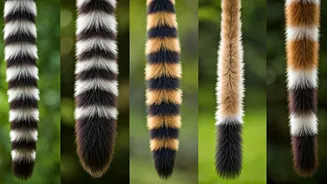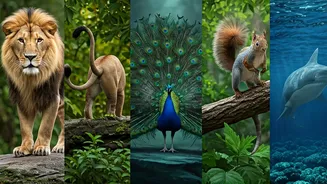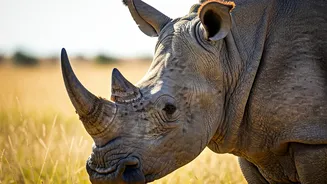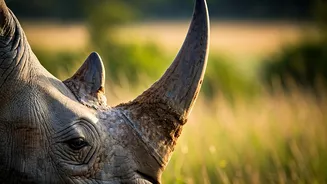Squirrel's Balancing Act
Squirrels are well-known for their fluffy, bushy tails, which serve a primary purpose: maintaining balance. When navigating the intricate network of branches
and leaping between trees, the tail acts like a rudder, providing stability and allowing for precise movements. This essential appendage helps them counter the forces of gravity and wind, ensuring they don't take a tumble. Beyond balance, the squirrel's tail also plays a role in communication, conveying emotions and warnings through various postures and movements. During cold weather, a squirrel will curl up and wrap itself in its tail, using it as a warm blanket, providing insulation to conserve body heat. Furthermore, the tail serves as a visual signal, helping squirrels recognize each other and establish social hierarchies within their community. The squirrel's tail is a multifaceted tool, supporting their survival in diverse ways.
The Peacock's Display
The male peacock's tail is arguably one of the most magnificent sights in the animal kingdom, and it is primarily used for attracting mates. The elaborate train of iridescent feathers, adorned with eye-like patterns, is displayed in a spectacular fan during courtship displays. This visual extravagance serves as a signal of the peacock's health, vitality, and genetic fitness, which indicates to the peahen that he is a good choice for breeding. The vibrant colors and patterns are not just random; they have evolved to maximize visual impact, catching the attention of potential mates. In addition to their role in mating, the tail feathers are also used in defensive behaviors. When threatened, a peacock can shake and vibrate its train, creating a rustling sound that might startle or deter predators. It is clear that the peacock's tail is a complex structure that serves both reproductive and defensive functions, adding to the peacock's overall survival strategy.
Crocodile's Powerhouse
A crocodile's tail is a powerful and versatile tool, primarily designed for locomotion and hunting. The strong, muscular tail provides the primary source of propulsion in the water, allowing the crocodile to move with great speed and agility. Its flat, laterally compressed shape acts like a paddle, creating powerful strokes that propel the crocodile through the water. This is essential for both catching prey and escaping predators. Aside from swimming, the crocodile’s tail also plays a crucial part in hunting tactics. Crocodiles are ambush predators, so they often lie in wait, submerged with only their eyes and nostrils visible. The tail is used to create a sudden burst of speed, allowing them to ambush unsuspecting prey. The tail's strength also allows crocodiles to perform impressive actions on land, like a quick lunge to capture animals on the riverbank. This is an essential aspect of their survival, providing a powerful means to hunt, escape, and control their aquatic environment.
Zebra's Swat and Signal
The zebra's tail is an essential tool for defense and social communication. The primary purpose of the zebra's tail is to swat away flies and other biting insects, which can be a major nuisance and health risk. Zebras spend a significant amount of time in open grasslands, and insect bites can spread diseases, so the tail is a crucial defense mechanism. Also, the tail is used for communication within the zebra herd. The position and movement of the tail convey information about the zebra's mood and intentions. For example, a relaxed tail indicates contentment, while a raised tail might signal alertness or alarm. The tail also helps zebras recognize each other, which strengthens social bonds and helps maintain group cohesion. It is an intricate part of their survival strategy, contributing to the zebra's health and social interactions.
The Leopard's Balance
Leopards, like squirrels, use their tails for maintaining balance, especially when moving through trees or stalking prey. Their long, muscular tails act as a counterbalance, helping them navigate branches, make sharp turns, and stay upright while hunting. As a predator that often hunts from elevated positions, a stable platform is crucial for success. In addition to balance, the leopard's tail also plays a role in communication. The position and movement of the tail can signal the leopard's mood and intentions, such as friendliness or aggression. Tail movements help to express feelings and establish relationships with other animals and in their interactions. Overall, the leopard's tail is an essential part of its physical and social life, contributing to its hunting efficiency and communication within its environment.






